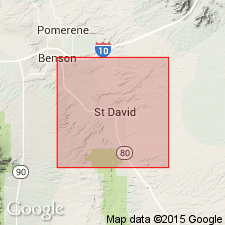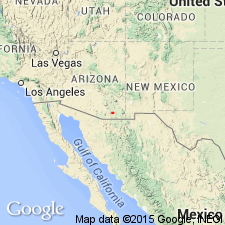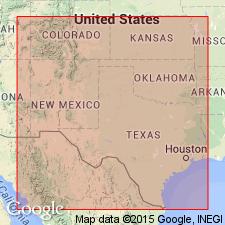
- Usage in publication:
-
- St. David Formation
- Modifications:
-
- Original reference
- AAPG geologic province:
-
- Pedregosa basin
Summary:
Pg. 984. St. David Formation. A fine-grained sequence of fluviatile and lacustrine sediments composed chiefly of silt and clay with some fine sand, fresh-water limestone, and water-laid pyroclastic units. Age based on vertebrate fossils is considered late Pliocene to Pleistocene (late Kansan).
Source: US geologic names lexicon (USGS Bull. 1350, p. 655).

- Usage in publication:
-
- St. David Formation
- Modifications:
-
- Original reference
- Dominant lithology:
-
- Silt
- Clay
- Sand
- Pyroclastics
- Paleosols
- AAPG geologic province:
-
- Pedregosa basin
Summary:
St. David Formation. Formal proposal of name. A complex assemblage of rocks having a variety of lithologic characteristics. Sediments are composed chiefly of silts and clays with fine sands, fresh-water-laid pyroclastic units, and paleosols. Dip of beds is 25 to 30 deg. N. or down the San Pedro Valley. Thickness of 600 feet of formation exposed from 3,600 feet to 4,200 feet in elevation. Total thickness much greater as shown by logs of wells in vicinity. Entire formation not exposed in anyone section. Exposed part of formation subdivided into lower red-bed division, a middle carbonate-enriched (white zones) division. Formation nearly everywhere covered by a sequence of reddish-orange fine to coarse gravels and coarse sands which in the field was termed "granite wash."
Type locality: in badlands topography along east and west sides of San Pedro Valley near St. David and Benson, Cochise Co., southeastern AZ.
Type section: includes section CR-1 through section CR-4, exposed in secs. 24 through 27, T. 18 S., R. 21 E., Cochise Co., southeastern AZ.
Supplemental sections: section PR-1 through PR-3 located in secs. 27 and 28, T. 17 S., R. 20 E., Cochise Co., southeastern AZ.
[Misprint (US geologic names lexicon, USGS Bull. 1350, p. 655): formal proposal of name published in Jour. Sed. Petrol., v. 37, no. 3, p. 774-789.]
Source: US geologic names lexicon (USGS Bull. 1350, p. 655).

- Usage in publication:
-
- St. David Formation
- Modifications:
-
- Biostratigraphic dating
- Geochronologic dating
- Paleomagnetics
- AAPG geologic province:
-
- Pedregosa basin
Summary:
Pg. 240+ (fig. 7.1), 261, 267. St. David Formation. In San Pedro Valley, Arizona, includes (descending): Curtis Ranch fauna; Huckleberry Ridge ash, about 2.01 Ma; California Wash fauna; Wolf Ranch fauna; Mendevil Ranch fauna; Benson fauna; and unnamed ash bed (about 3.1 Ma) at base. Age is Blancan to Irvingtonian NALMA; Gauss to Matuyama chron zone (normal polarity zone 2An.2n up to base of reversed polarity zone 1r.1n).
Source: Publication.
For more information, please contact Nancy Stamm, Geologic Names Committee Secretary.
Asterisk (*) indicates published by U.S. Geological Survey authors.
"No current usage" (†) implies that a name has been abandoned or has fallen into disuse. Former usage and, if known, replacement name given in parentheses ( ).
Slash (/) indicates name conflicts with nomenclatural guidelines (CSN, 1933; ACSN, 1961, 1970; NACSN, 1983, 2005, 2021). May be explained within brackets ([ ]).

